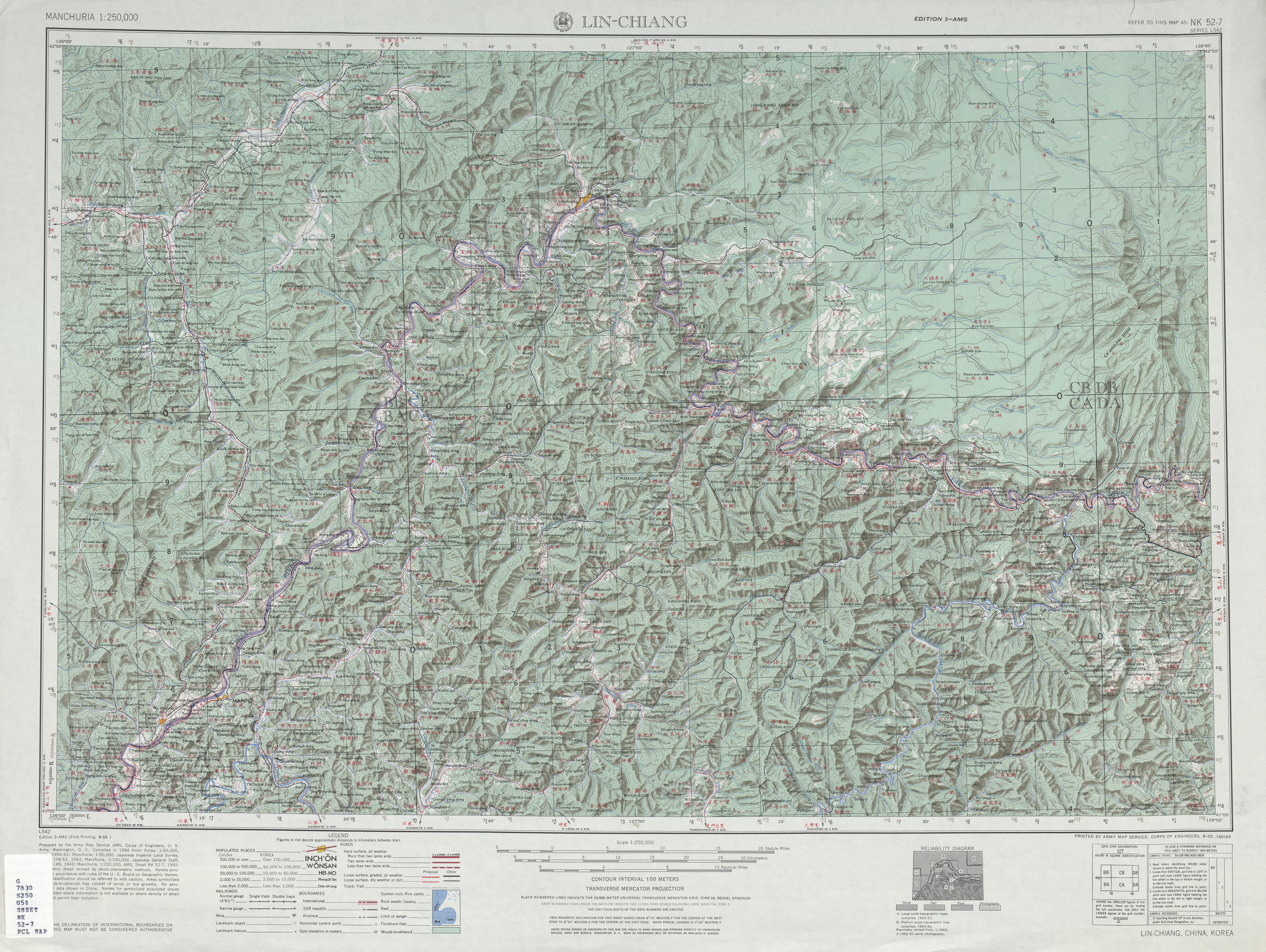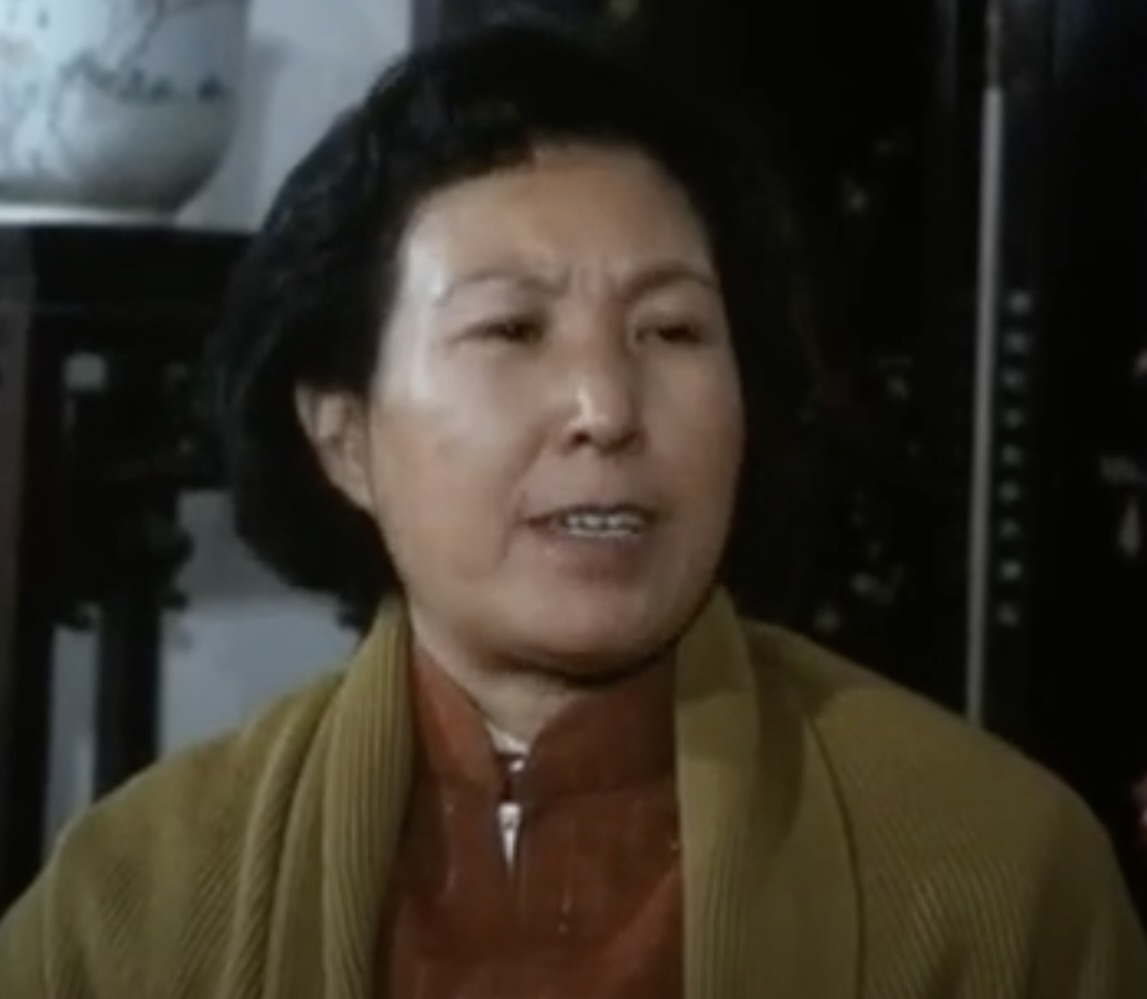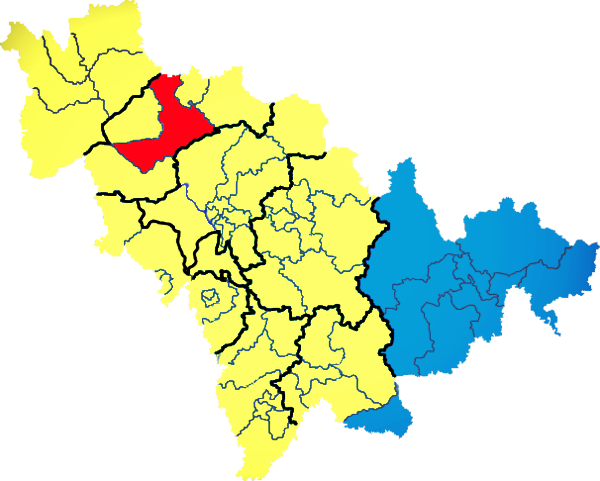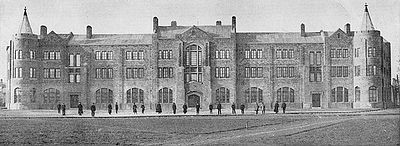|
Yunhe (princess)
Yunhe (24 November 1911 – 16 February 2002), better known as Jin Xinru, was a Chinese princess of the Qing dynasty. Life Early life Yunhe was born in the Manchu Aisin Gioro clan in 1911 as the second daughter of Prince Chun and Princess Consort Youlan. She was also a full sister of Puyi (the Xuantong Emperor) the last Emperor of China. She had three other full siblings ( one brother and two sisters) and six half siblings (two brothers and four sisters). She was referred to as "Second Princess" in her childhood. In November 1924, the warlord Feng Yuxiang took control of Beijing and forced the former imperialy family out of the Forbidden City. They moved to Tianjin's Heping District. In Tianjin, Yunhe and her siblings learned the Japanese language and played tennis. Life in Manchuria In 1931, Puyi was installed as emperor of Manchukuo, a puppet state established by the Empire of Japan in northeastern China. On 9 March 1932, Yunhe attended the inuguration ceremony of Puy ... [...More Info...] [...Related Items...] OR: [Wikipedia] [Google] [Baidu] |
House Of Aisin-Gioro
The House of Aisin-Gioro is a Manchu clan that ruled the Later Jin dynasty (1616–1636), the Qing dynasty (1636–1912), and Manchukuo (1932–1945) in the history of China. Under the Ming dynasty, members of the Aisin Gioro clan served as chiefs of the Jianzhou Jurchens, one of the three major Jurchen tribes at this time. Qing bannermen passed through the gates of the Great Wall in 1644, and eventually conquered the short-lived Shun dynasty, Xi dynasty and Southern Ming dynasty. After gaining total control of China proper, the Qing dynasty later expanded into other adjacent regions, including Xinjiang, Tibet, Outer Mongolia, and Taiwan. The dynasty reached its zenith during the High Qing era and under the Qianlong Emperor, who reigned from 1735 to 1796. This reign was followed by a century of gradual decline. The house lost power in 1912 following the Xinhai Revolution. Puyi, the last Aisin-Gioro emperor, nominally maintained his imperial title in the Forbidden City unti ... [...More Info...] [...Related Items...] OR: [Wikipedia] [Google] [Baidu] |
Tianjin
Tianjin is a direct-administered municipality in North China, northern China on the shore of the Bohai Sea. It is one of the National Central City, nine national central cities, with a total population of 13,866,009 inhabitants at the time of the 2020 Chinese census. Its metropolitan area, which is made up of 12 central districts (other than Baodi District, Baodi, Jizhou District, Tianjin, Jizhou, Jinghai District, Jinghai and Ninghe District, Ninghe), was home to 11,165,706 inhabitants and is also the world's 29th-largest agglomeration (between Chengdu and Rio de Janeiro) and 11th-List of cities proper by population, most populous city proper. Tianjin is governed as one of the four municipalities (alongside Beijing, Shanghai, and Chongqing) under the direct-administered municipalities of China, direct administration of the State Council of the People's Republic of China, State Council of Government of China, China. The city borders Hebei Province and Beijing Municipality, bounded ... [...More Info...] [...Related Items...] OR: [Wikipedia] [Google] [Baidu] |
Tonghua
Tonghua ( zh, s=通化 , p=Tōnghuà) is a prefecture-level city in the south of Jilin province, People's Republic of China. It borders North Korea's Chagang Province to the south and southeast, Baishan to the east, Jilin City to the north, Liaoyuan to the northwest, and Liaoning province to the west and southwest. Its population was 1,812,114 registered residents at the 2020 census living in an area of . Its built-up (or metro) area made of the two urban districts was home to 446,917 inhabitants. It is known as one of the five medicine production centres in China. History Human settlement in the Tonghua area dates from about 6,000 years ago. In the Western Han Dynasty, Tonghua belonged to the Liaodong Fourth Commandery (). Tonghua was the birthplace of Goguryeo culture and shaman culture. The Goguryeo kingdom established its capital at Gungnae in 425 A.D., which, together with the Tombs of the Ancient Gogoryeo Kingdom, represents the only successful, independent submiss ... [...More Info...] [...Related Items...] OR: [Wikipedia] [Google] [Baidu] |
Siberia
Siberia ( ; , ) is an extensive geographical region comprising all of North Asia, from the Ural Mountains in the west to the Pacific Ocean in the east. It has formed a part of the sovereign territory of Russia and its predecessor states since the lengthy conquest of Siberia, which began with the fall of the Khanate of Sibir in 1582 and concluded with the annexation of Chukotka in 1778. Siberia is vast and sparsely populated, covering an area of over , but home to roughly a quarter of Russia's population. Novosibirsk, Krasnoyarsk, and Omsk are the largest cities in the area. Because Siberia is a geographic and historic concept and not a political entity, there is no single precise definition of its territorial borders. Traditionally, Siberia spans the entire expanse of land from the Ural Mountains to the Pacific Ocean, with the Ural River usually forming the southernmost portion of its western boundary, and includes most of the drainage basin of the Arctic Ocean. I ... [...More Info...] [...Related Items...] OR: [Wikipedia] [Google] [Baidu] |
Liaoning
) , image_skyline = , image_alt = , image_caption = Clockwise: Mukden Palace in Shenyang, Xinghai Square in Dalian, Dalian coast, Yalu River at Dandong , image_map = Liaoning in China (+all claims hatched).svg , mapsize = 275px , map_alt = Map showing the location of Liaoning Province , map_caption = Map showing the location of Liaoning Province , coordinates = , subdivision_type = Country , subdivision_name = China , named_for = —"Liao River, Liao (River)" —"pacification" "Pacified of the Liao (River)" , seat_type = Capital , seat = Shenyang , seat1_type = , seat1 = , parts_type = Divisions , parts_style = para , p1 = 14 Prefectures of China, prefectures , p2 = 100 Counties of China, counties , p3 = 1511 Townships of China, townships , government_type = Provinces of ... [...More Info...] [...Related Items...] OR: [Wikipedia] [Google] [Baidu] |
Shenyang
Shenyang,; ; Mandarin pronunciation: ; formerly known as Fengtian formerly known by its Manchu language, Manchu name Mukden, is a sub-provincial city in China and the list of capitals in China#Province capitals, provincial capital of Liaoning province. It is the province's most populous city with a population of 9,070,093 as of the 2020 Chinese census, 2020 census, also making it the largest city in Northeast China by urban population, and the second-largest by metropolitan population (behind Harbin). The Shenyang metropolitan area is one of the major megalopolises in China, with a population of over 23 million. The city's administrative region includes the ten metropolitan district (China), districts, the county-level city of Xinmin, Liaoning, Xinmin, and the counties of the People's Republic of China, counties of Kangping County, Kangping and Faku County, Faku. Shenyang has been controlled by numerous different states and peoples during its history. In the 14th century, the ... [...More Info...] [...Related Items...] OR: [Wikipedia] [Google] [Baidu] |
Linjiang
Linjiang (; listed as Linkiang on old maps) is a county-level city in Baishan, Jilin, China. It is located to the east of Tonghua, and borders North Korea along the Yalu River. Culture During 1953–76, there was a total of twenty-one Chinese films being shot on location in Linjiang, including '' Visitors on the Icy Mountain.'' Geography and climate Linjiang has a monsoon-influenced humid continental climate (Köppen ''Dwa''), with long, very cold winters, and very warm, humid summers. Monthly average temperatures range from in January to in July, and the annual mean is . Though the annual total is generous, precipitation is quite low during the winter and rainfall is concentrated in the months of June through August. Sunshine is generous but falling far short of the central and western parts of Jilin; with monthly percent possible sunshine ranging from 42% in July to 60% in February, there are 2,232 hours of bright sunshine annually. Administrative divisions There are si ... [...More Info...] [...Related Items...] OR: [Wikipedia] [Google] [Baidu] |
Second Sino-Japanese War
The Second Sino-Japanese War was fought between the Republic of China (1912–1949), Republic of China and the Empire of Japan between 1937 and 1945, following a period of war localized to Manchuria that started in 1931. It is considered part of World War II, and often regarded as the beginning of World WarII in Asia. It was the largest Asian war in the 20th century and has been described as The Asian Holocaust, in reference to the scale of Japanese war crimes against Chinese civilians. It is known in China as the War of Resistance against Japanese Aggression. On 18 September 1931, the Japanese staged the Mukden incident, a false flag event fabricated to justify their Japanese invasion of Manchuria, invasion of Manchuria and establishment of the puppet state of Manchukuo. This is sometimes marked as the beginning of the war. From 1931 to 1937, China and Japan engaged in skirmishes, including January 28 incident, in Shanghai and in Northern China. Chinese Nationalist and C ... [...More Info...] [...Related Items...] OR: [Wikipedia] [Google] [Baidu] |
Li Yuqin
Li Yuqin (15 July 1928 – 24 April 2001), sometimes referred to as the "Last Imperial Concubine" (), was the fourth wife of China's last emperor Puyi. She married Puyi when the latter was the nominal ruler of Manchukuo, a puppet state established by the Empire of Japan during the Second Sino-Japanese War. Biography Li Yuqin was a Han Chinese woman who was born in Changchun to a middle class family from Shandong. Her father, Li Degui was a translator to a local missionary organisation, while her mother, Wang Xiuru, was the owner of a small silk farm in Changchun’s outskirts. Both sides of Li’s family served the imperial court, with her paternal great grandmother being the wet nurse to the Xianfeng Emperor’s daughter and her maternal family being court physicians. After the fall of the Qing dynasty, many people who worked in the imperial court were banished by republican forces to the countryside provinces, which is how the Li family ended up in the commoner class. Li had t ... [...More Info...] [...Related Items...] OR: [Wikipedia] [Google] [Baidu] |
Jilin
) , image_skyline = Changbaishan Tianchi from western rim.jpg , image_alt = , image_caption = View of Heaven Lake , image_map = Jilin in China (+all claims hatched).svg , mapsize = 275px , map_alt = Map showing the location of Jilin Province , map_caption = Map showing the location of Jilin Province , coordinates = , subdivision_type = Country , subdivision_name = China , named_for = from ''girin ula'', a Manchu language, Manchu phrase meaning "along the river" , seat_type = Capital , seat = , seat1_type = , seat1 = , parts_type = Divisions , parts_style = para , p1 = 9 Prefectures of China, prefectures , p2 = 60 Counties of China, counties , p3 = 1006 Townships of China, townships , government_type = Provinces of China, Province , governing_body = Jilin Provinci ... [...More Info...] [...Related Items...] OR: [Wikipedia] [Google] [Baidu] |
Changchun
Changchun is the capital and largest city of Jilin, Jilin Province, China, on the Songliao Plain. Changchun is administered as a , comprising seven districts, one county and three county-level cities. At the 2020 census of China, Changchun had a population of 9,066,906; its metro area, comprising five districts and one development area, had a population of 5,019,477. Shuangyang and Jiutai districts are not urbanized yet. It is one of the biggest cities in Northeast China, along with Shenyang, Dalian and Harbin. The name of the city means "long spring" in Chinese language, Chinese. Between 1932 and 1945, Changchun was renamed Xinjing ( zh, c=新京 , p=Xīnjīng, l=new capital) or Hsinking by the Kwantung Army as the capital of the Imperial Japanese puppet state of Manchukuo, occupying modern Northeast China. After the Proclamation of the founding of the People's Republic of China, foundation of the People's Republic of China in 1949, Changchun was established as the provincial ... [...More Info...] [...Related Items...] OR: [Wikipedia] [Google] [Baidu] |
Empire Of Japan
The Empire of Japan, also known as the Japanese Empire or Imperial Japan, was the Japanese nation state that existed from the Meiji Restoration on January 3, 1868, until the Constitution of Japan took effect on May 3, 1947. From Japan–Korea Treaty of 1910, 1910 to Japanese Instrument of Surrender, 1945, it included the Japanese archipelago, the Kuril Islands, Kurils, Karafuto Prefecture, Karafuto, Korea under Japanese rule, Korea, and Taiwan under Japanese rule, Taiwan. The South Seas Mandate and Foreign concessions in China#List of concessions, concessions such as the Kwantung Leased Territory were ''de jure'' not internal parts of the empire but dependent territories. In the closing stages of World War II, with Japan defeated alongside the rest of the Axis powers, the Japanese Instrument of Surrender, formalized surrender was issued on September 2, 1945, in compliance with the Potsdam Declaration of the Allies of World War II, Allies, and the empire's territory subsequent ... [...More Info...] [...Related Items...] OR: [Wikipedia] [Google] [Baidu] |









